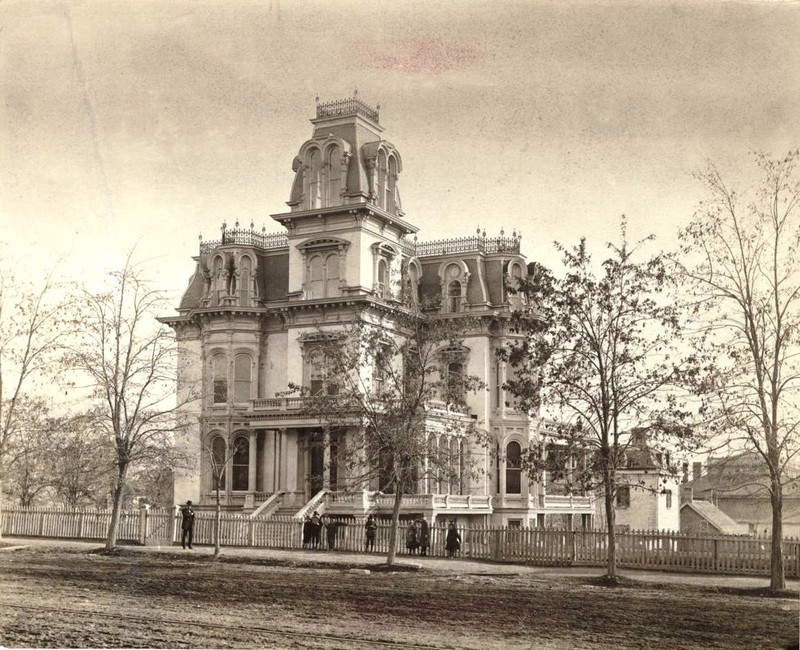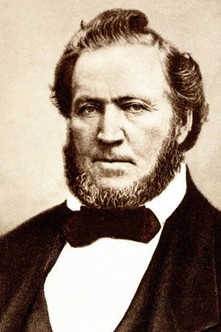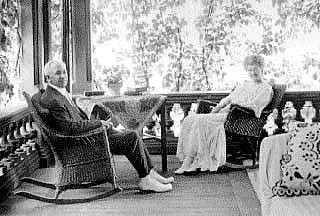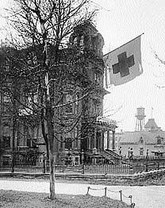The Gardo House (1873-1921)
Introduction
Text-to-speech Audio
Images
The Gardo House during John Taylor and Wilford Woodruf'fs stay.

A photo of Brigham Young, who authorized construction of the Gardo House.

The Holmes couple relaxing in the Gardo House.

The Gardo House while the Red Cross resided in it.

Backstory and Context
Text-to-speech Audio
Church of Jesus Christ of Latter-Day Saints leader Brigham Young led efforts to construct a vast estate at this location in 1873. Construction was guided by Joseph Ridged and William Harrison Folsom, two notable designers of the area at the time.
Construction for the home was slow, with delays caused in by the time it took to receive building materials. Due to these setbacks, Brigham Young never witnessed the completion of the home. John Taylor took Young's place as the leader of the church, and he moved into the home in 1879. Young had an office in the home that was the location of many meetings attended by church leaders.
One of the leading concerns at this time was the Edmunds Act, an 1882 law that made polygamy a felony punishable by a fine or prison time. The Edmunds-Tucker Act followed five years later and revoked the church's incorporation and ordered the seizure of church property valued over $50,000. The church eventually barred the practice of polygamy, but the laws at this time was understood by many members as a hostile act given the long history of persecution they had faced in previous decades.
Wilford Woodruff was the next president of the Church after John Taylor's death in 1887 and also maintained an office at the Gardo House. Because the church owned the property and faced fees and taxes because of the Edmunds-Tucker Act, church leaders tried to have this home certified as a parsonage. The effort failed and the Gardo House was eventually leased to the Keely Institute. This organization focused on alcohol and drug addiction and only used the home for a year. Church leaders decided to rent out the home over the next few years.
The Gardo House was purchased by Edward F. Holmes in 1901 as a present for his wife. The Holmes redecorated their new home, bringing the mansion to a new level of notoriety. The couple held lavish parties with various entertainments and had hundreds of visitors on days at home. The Holmes resided in the home till around the start of World War I. Becoming more accustom to their home in California, they listed the mansion, yet could not find a suitable buyer. Due to this, they lent the Gardo House to the Red Cross who commonly held lessons on health and basic skills till the war's end.
With the war’s end, the Holmes sold the Gardo House back to the church on March 20, 1920, for $100,000. Plans were made by the church to use the Holmes’ additions to the home for a school of music. Before these plans came to fruition, the Federal Reserve Bank offered to buy the home for an additional $15,000 due to needing more space. From this offer, the church decided to move the Gardo House, yet the new location they planned on is unknown. After assessing the mansion, it was deemed beyond the church’s budget, having an aged foundation and in need of costly repairs. The Federal Reserve Bank appointed the home to be demolished with the Gardo House facing deconstruction on November 26, 1921.Cite This Entry
Morris, James and Clio Admin. "The Gardo House (1873-1921)." Clio: Your Guide to History. March 20, 2019. Accessed March 14, 2025. https://theclio.com/entry/76699
Sources
2. Photo of the Holmes. Utah History to Go. Accessed March 19, 2019. https://historytogo.utah.gov/utah_chapters/mining_and_railroads/thegardohouse.html.
3. Photo of the Gardo House with Red Cross Flag. Utah History to Go. Accessed March 19, 2019. https://historytogo.utah.gov/utah_chapters/mining_and_railroads/thegardohouse.html.
4. Savage, Charles Roscoe. Photo of the Gardo House. Wikimedia. Accessed March 18, 2019. https://commons.wikimedia.org/wiki/File:The_Gardo_House.jpg.
5. The Gardo House: A History of the Mansion and Its Occupants. Utah History to Go. Accessed February 24, 2019. https://historytogo.utah.gov/utah_chapters/mining_and_railroads/thegardohouse.html.
